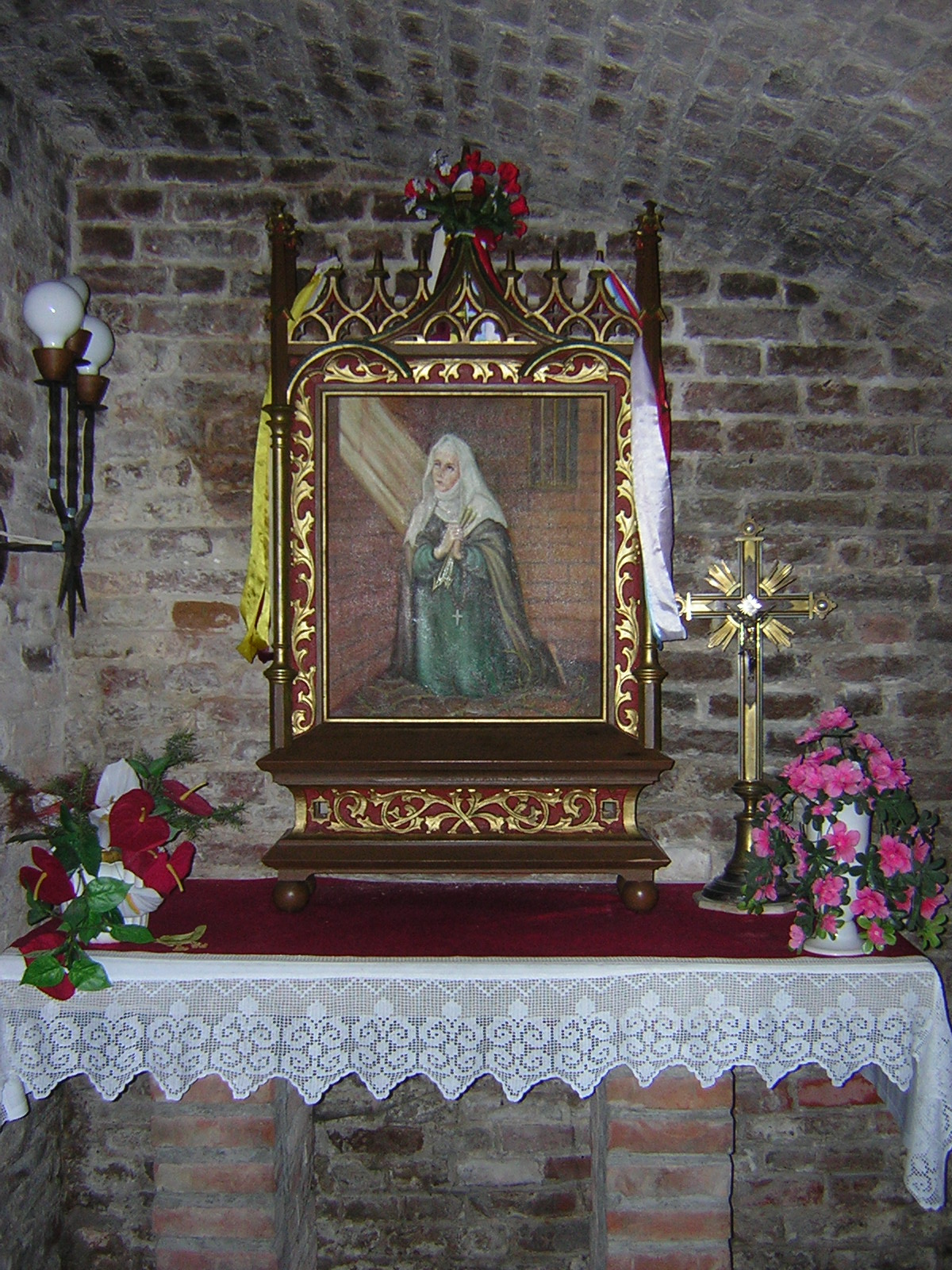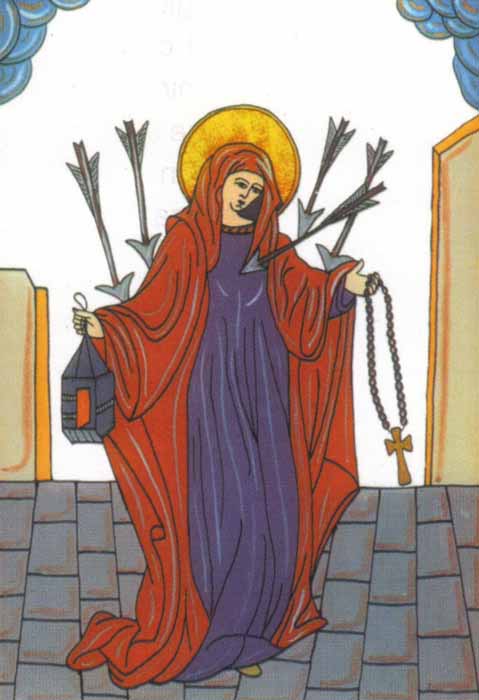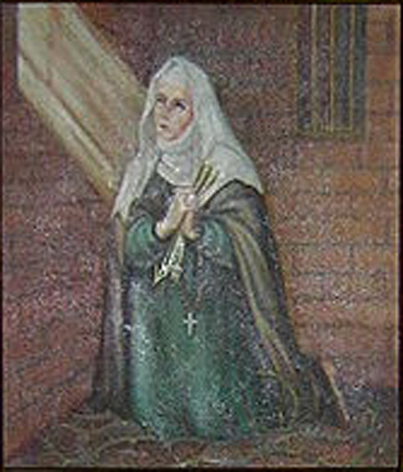Bienheureuse Dorothée de Montau
Mystique
et recluse (✝ 1393)
Épouse d'un modeste
ouvrier de Gdansk en Pologne, mère de neuf enfants, elle se retira du monde
quand elle fut veuve, pour se consacrer à la prière. Elle se fit emmurer
recluse tout contre la cathédrale de Marienwerder. Sa cellule avait trois
fenêtres: l'une vers le ciel, la deuxième vers l'autel, la troisième vers le
cimetière. Elle recevait beaucoup de visiteurs que sa charité spirituelle
encourageait. Ses confesseurs ont rapporté, après sa mort, les communications
célestes dont elle recevait les grâces.
À Marienwerder en Podolie polonaise, l’an 1394, la bienheureuse Dorothée de Montau, veuve, qui vécut recluse dans une cellule touchant la cathédrale, adonnée continuellement à la prière et à la pénitence.
Martyrologe
romain
Dorothée de
Montau
Religieuse bénédictine, Bienheureuse
1347-1394
La bienheureuse Dorothée naquit le 6
février 1347 à Montau, en Prusse (aujourd'hui en Pologne) sur la Vistule. Dès
sa jeunesse, elle se mortifiait. Elle se maria à seize ans avec Adalbert,
armurier de son état et plus âgé que la jeune femme.
Le ménage vivait fort chrétiennement,
malgré les accès de colère passagers d'Adalbert. Ils s'installèrent à Dantzig,
grand port de commerce de la Hanse. Dorothée donna naissance à neuf enfants.
Seulement une fille atteint l'âge adulte. Elle devint bénédictine et sa mère
lui dédia un traité de spiritualité.
À 31 ans, Dorothée connut ses premières
extases, un état d'amour languissant pour son Seigneur. Son mari la désapprouva
au début, puis ils décidèrent de faire des pèlerinages. Lors d'un pèlerinage à
Rome — cette fois-ci sans Adalbert — celui-ci mourut.
C'était en 1390.
Profondément émue, Dorothée se rendit à
Marienwerder, où elle rencontra celui qui allait devenir son directeur
spirituel : Jean de Marienwerder (1343 à 1417). Il avait été théologien à
Prague et faisait partie de l'Ordre Teutonique. Sage et avisé, il commença à
prendre note des visions de Dorothée et de son enseignement.
A partir de 1393, Dorothée décida de
vivre en recluse dans une cellule attenante à la cathédrale. Elle communiait
tous les matins, ce qui à l'époque était exceptionnel. Elle édifia de nombreux
fidèles...
Elle s'inspirait aussi de sainte Brigitte,
dont les reliques avaient voyagé à Dantzig, lorsque Dorothée y vivait. Elle se
sentait proche de la spiritualité dominicaine.
Grâce à son confesseur, elle put éditer
des traités spirituels et deux “vitae”. De nombreux écrits de Dorothée
transcrivent ses visions, son amour de l'Eucharistie, son chemin de pénitence
jusqu' à sa transformation dans le Saint-Esprit vers l'union mystique. Cette
âme féminine et profondément aimante fait partie des grandes mystiques à
redécouvrir !
Elle mourut à Marienweder le 25 juin
1394 et fut dès lors considérée comme l'une des patronnes de la Prusse.
SOURCE : http://ut-pupillam-oculi.over-blog.com/article-20752669.htmlDorothy of Montau, Widow (PC)
Born at Montau near Marienburg, Prussia, Germany, on February 6, 1347; died
June 25, 1394. Though she was never canonized, Saint Dorothy is widely
venerated in central Europe, particularly among the Prussians, who have
selected her as their patron saint. Like Saint Catherine of Siena and Saint
Bridget of Sweden, who were her contemporaries, she was favored by divine grace
with many visions, revelations, and ecstasies, especially during the last years
of her life.
As a 17-year-old
peasant girl, she married a wealthy swordsmith from Danzig named Albert
(Albrecht) by whom she had nine children. Of these only the youngest survived,
a daughter who later became a Benedictine nun. Albert appears to have been
surly and bad- tempered, and it seems likely that their married life, at least
in its early years, was far from ideal. However, Dorothy's gentleness,
fortitude, and kindness gradually softened him, and in 1384, he agreed to
accompany her on a pilgrimage to Aachen.
After other
pilgrimages to Einsiedeln and Cologne, they planned to make one to Rome for the
jubilee that was to be held in 1390; but while they were making their
preparations, Albert fell ill and so Dorothy went alone, travelling on foot and
begging her food. By the time she returned from Rome, where she had been
delayed by a sickness, her husband had died.
Now that she had
become a widow, Dorothy was able to fulfill a dream she had long cherished of
retiring from the world. In 1391, she went to Marienwerder where, after
spending two years on probation, she became a recluse in the church of the
Teutonic Knights.
On May 2, 1393, she
had herself walled up in a cell that measured 6' x 6' and was about 9' tall. Of
the three windows one opened to the sky, the second to a cemetery (and through
which she also received food) and the third on to the altar of the church
where, as was often the custom in those regions, the Blessed Sacrament was
exposed all day.
Like many others,
Dorothy had an intense devotion to the Blessed Sacrament and was often favored
with mystic visions of it. Her reputation for holiness grew rapidly and many
people came to her seeking counsel or miraculous cures.
However, the rigors
of her mode of life, added to the severe austerities she practiced, soon broke
her health and she died in May 1394, after living only a little more than a
year in her cell. Many miracles were attributed to her, and an account of her
visions and ecstasies has been left by her confessor (Benedictines, Delaney,
Encyclopedia).
Dorothy's emblem is
a lantern and a rosary. Sometimes she is surrounded by arrows in paintings of
her. Venerated at Montau and Marienwerder, Prussia (Roeder).
SOURCE
: http://www.saintpatrickdc.org/ss/1030.shtml
Transcription. This article was transcribed for New Advent by Marcia L. Bellafiore.
Blessed Dorothy
of Montau
ST. DOROTHEA OF
MONTAU, recluse, born at Montau, 6 February, 1347, d. at
Marienwerder, 25 June, 1394. At the age of seventeen she married
the sword-cutler Albrecht of Danzig, a hot-tempered man,
whose nature underwent a change
through her humility and gentleness. Both made frequent pilgrimages to Cologne, Aachen, and Einsiedeln, and they intended (1390) to visit Rome also; but Albrecht was prevented by illness and
remained at home where he died, while Dorothea journeyed to Rome alone. Of their nine children all died, except one
daughter who joined the Benedictines. In the summer of 1391 Dorothea moved to
Marienwerder, and on 2 May, 1393, with the permission of the chapter
and of the Teutonic Order, established a hermitage near the cathedral. She led a very austere life.
Numerous visitors sought her advice and consolation, and she had wonderful visions
and revelations. Her confessor,
the deacon John of
Marienwerder, a learned theologian, wrote down her communications and composed a Latin
biography in seven books, "Septililium", besides a German
life in four books. She was
never canonized, but the people honoured her as the guardian
of the country of the Teutonic Knights and Patroness
of Prussia." Her feast is celebrated on 25 June, in some places on 30
October. The church at
Marienwerder is now in the hands of the Lutherans; her relics cannot be found.
Meier, Gabriel.
"St. Dorothea." The Catholic Encyclopedia. Vol. 5.
New York: Robert Appleton Company, 1909. 31
Oct. 2015 <http://www.newadvent.org/cathen/05135d.htm>.
Transcription. This article was transcribed for New Advent by Marcia L. Bellafiore.
Ecclesiastical approbation. Nihil
Obstat. May 1, 1909. Remy Lafort, Censor. Imprimatur. +John M. Farley, Archbishop of New York.
Blessed Dorothy
of Montau
Also
known as
§
Dorota
z Matowów
§
Dorothea
of Montau
§
Dorothea
Swartz
§
Dorothea
von Montau
§
Dorthea
von Montau
§
25
June
Profile
Peasant, one of nine children. Married at age 17 to a wealthy swordsmith named Adalbert or Albrecht of Prague (in modern Czech Republic). Bore nine children, only one of whom survived; the girl became a Benedictine nun. Difficult marriage;
she suffered abuse from her husband, but she encouraged him in his trade and his faith. Went on a pilgrimage to Rome, Italy in 1389, fell ill, and was forced to stay for many weeks, during which time her
husband died at home. Widow. Nun at Marienwerser. Great devotion to the Blessed Sacrament; the
absorption of the Eucharist “agitated her like boiling water; had she been
allowed, she would willingly have torn the host from the priest‘s hands to bring it to her mouth….” Lived in a 6×9 foot cell.
Visionary. Prophetess. Miracle
worker.
Born
§
6
February 1347 at Groß Montau, Prussia, one of the states of the Teutonic Knights (modern Matowy Wielkie, Poland)
§
25
January 1394 at Marienwerder, Kwidzyn, Prussia (in modern Poland) of natural causes
§
9
January 1976 by Pope Paul VI (cultus confirmed)
§
lantern
§
rosary
§
brides
§
Prussia
§
widows
Beata Dorotea da Montau Vedova
† 1394
Martirologio
Romano: A Marienwerder nella Prussia polacca, beata Dorotea da Montau, che,
vedova, visse reclusa in una cella costruita accanto alla cattedrale, dandosi
senza sosta ad una vita di orazione continua e di penitenza.
Dorotea
nacque il 6 febbraio 1347 in Prussia, nella cittadina di Montau, sulla Vistola.
Le antiche biografie raccontano che fin da giovanissima mortificava il proprio
corpo e che ricevette le stimmate invisibili, i cui dolori tenne nascosti. Andò
sposa a sedici anni, nella cittadina di Danzica (Polonia), ad un maturo
armaiolo, Adalberto, benestante e buon cristiano, ma dal carattere difficile. Ebbero nove figli che morirono tutti in giovane età, eccezion fatta per
una che vestirà l’abito benedettino a Kulm. A lei la santa dedicherà un piccolo trattato di
vita spirituale.
A trentuno anni Dorotea ebbe le prime estasi, lo stato di amore languente per
il Signore. Inizialmente ricevette dal marito solo rimproveri, in seguito però
si impegnarono di comune accordo alla continenza e andarono pellegrini ad
Aquisgrana. Durante un successivo viaggio a Roma di Dorotea, per venerare le
tombe degli apostoli, Adalberto morì (1390) e Dorotea, profondamente
trasformata, si trasferì a Marienwerder. Qui incontrò il suo direttore
spirituale, Giovanni da Marienwerder (1343-1417), dell’Ordine Teutonico,
professore a Praga. Era un saggio teologo e, accortosi della grandezza
spirituale della penitente, iniziò nel 1392 a trascrivere le sue visioni e il
suo insegnamento. Nel 1393 Dorotea si ritirò da reclusa in un locale nei pressi
della cattedrale, facendo ogni giorno la comunione, cosa a quei tempi
eccezionale. Con l’esempio edificava quanti andavano a trovarla e le vennero
attribuite diverse conversioni. Non frequentò mai una scuola, ma aveva un
discreto bagaglio culturale, grazie ai suoi viaggi e ai contatti con eminenti
ecclesiastici. Oltre all’Ordine Teutonico, fu vicina alla spiritualità
domenicana ed ebbe come modello s. Brigida, le cui reliquie passarono per
Danzica nel 1374 e di cui conobbe la vita e le rivelazioni.
Grazie all’intuito del confessore, tra il 1395 e il 1404, vennero alla luce
diverse opere. Furono edite due “vitae” dai Bollandisti (una rimase inedita) e
il “Septililium”, in cui i carismi della mistica sono presentati come effusioni
straordinarie dello Spirito Santo. Sono sette le grazie ricevute da Dio: “de
caritate”, “de Spiritus Sanctus missione”, “de Eucharistia”, “de
contemplatione”, “de raptu”, “de perfectione vitae christianae”, “de
confessione” . C’è poi il “Liber de festis” in cui le visioni sono riferite
secondo le ricorrenze liturgiche. La dottrina di Dorotea si propone di
rinnovare l’uomo attraverso tre percorsi: rimuovere il peccato che toglie
all’uomo la somiglianza a Dio, rendendolo simile alle bestie, purificarsi
attraverso l’umiltà e le penitenze che fanno crescere le virtù teologali e
morali, partecipazione alla Passione di Cristo, dedizione ai poveri, desiderio
dell’Eucaristia. Attraverso un lungo percorso di rinnegamento
di sé l’anima è successivamente, in modo graduale, trasformata dallo Spirito
Santo. Lo stadio ultimo è quello “unitivo”, che inizia col rinnovamento del
cuore. Gesù
parla a Dorotea, contrapponendo i suoi peccati alla beatitudine celeste,
portandola al matrimonio spirituale con Dio. L’anima sente la presenza e la
volontà divina, vivendo in sua costante uniformità, come in una dimora,
ricevendo virtù, doni, beatitudini, frutti. È la perfezione cristiana, che si
può raggiungere solo con la grazia del Signore.
Dorotea morì a Marienwerder il 25 giugno 1394 e fu subito venerata come santa e
patrona della Prussia. È rappresentata con in mano il libro delle rivelazioni,
la corona del rosario e cinque frecce, le stimmate. La sua spiritualità è stata
paragonata a quella di S. Brigida e S. Caterina da Siena.
Autore: Daniele Bolognini


